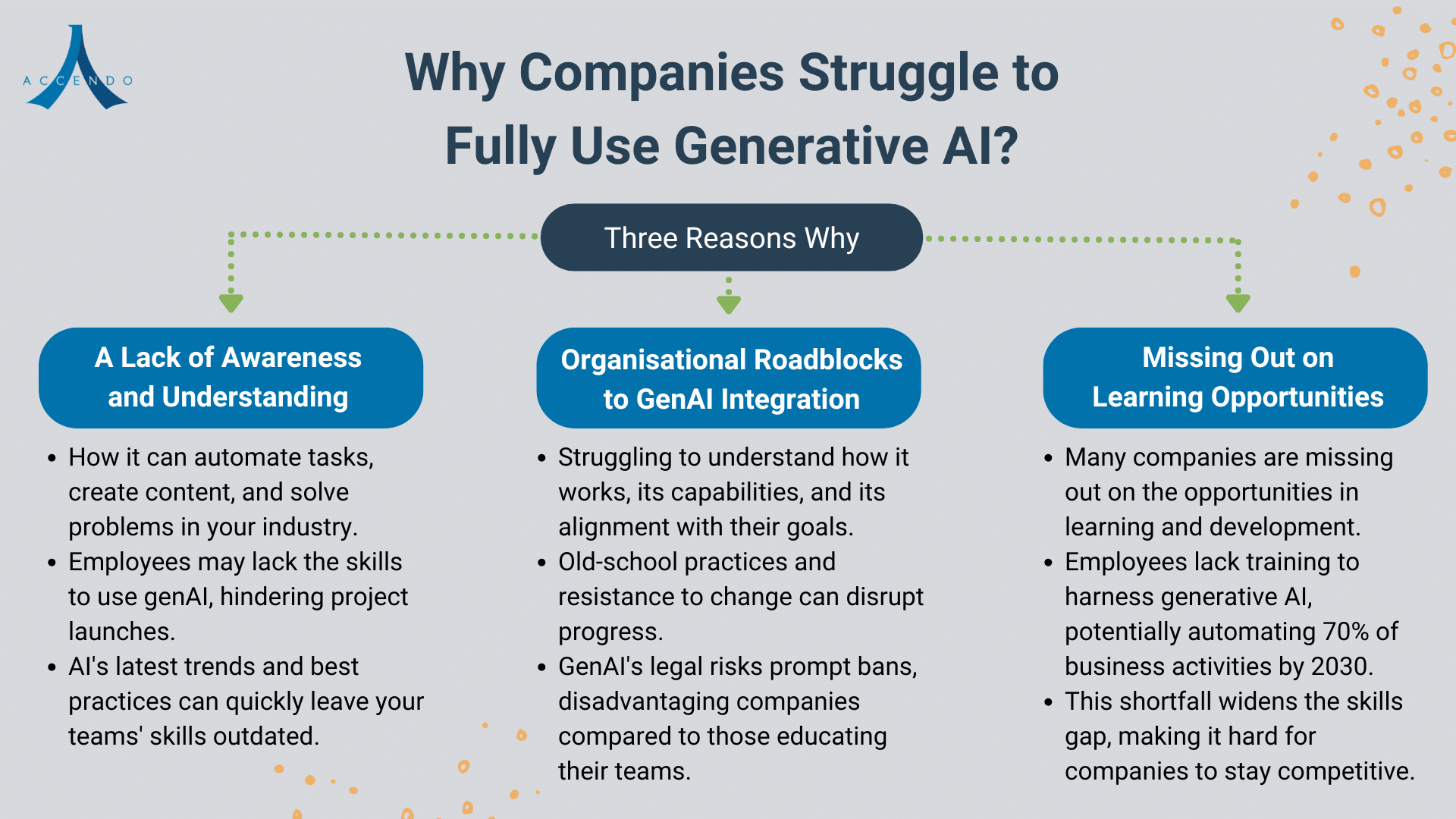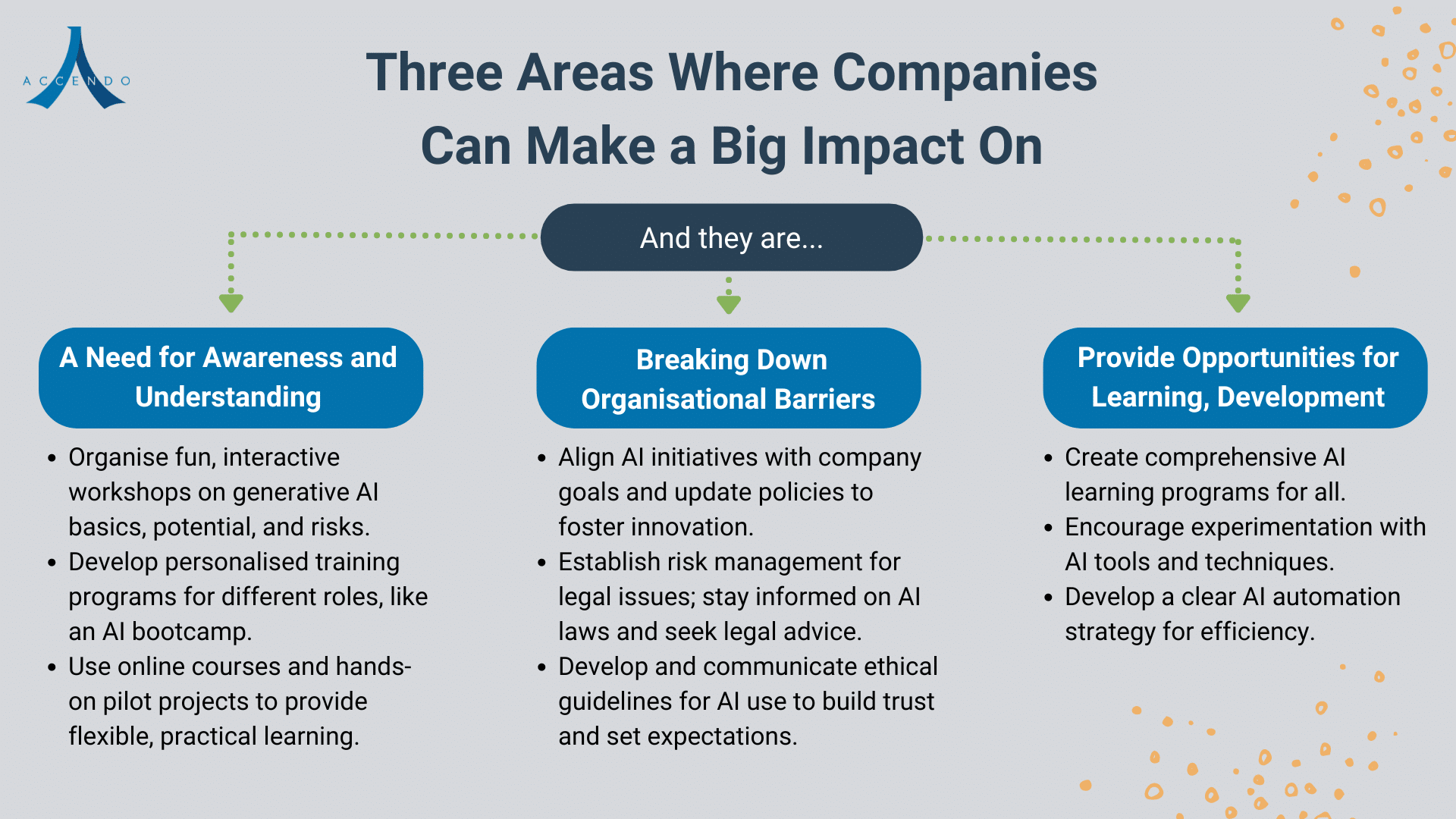Summary
Generative AI is rapidly becoming an integral part of our everyday lives, transforming how we interact with technology, perform tasks, and make decisions. But organisations are having a tough time keeping up with how fast AI is evolving. The benefits may be huge, but many businesses are just not ready and don’t realise that around 40% of their employees might need new skills to keep up with AI. Our article explores the reasons why the generative AI skills gap widens for most companies and how to bridge it to fully leverage all that it has to offer.
Key Takeaway
Generative AI holds immense potential to transform industries, but many companies aren’t tapping into it fully yet due to a big skills and awareness gap. To bridge this gap, companies need to understand its capabilities, invest in training their teams, and stay on top of the ethical and practical issues.
What is Generative AI and Why You Need to Understand It
Generative AI apps like ChatGPT and Copilot have captured everyone’s attention. They’re super handy because almost anyone can use them for communication and creativity, plus they can chat with you in a natural way. These AI tools can handle a bunch of everyday tasks, like sorting and classifying data. But what really gets people excited is their ability to write, compose music, and create digital art.
The history of generative AI goes back to the mid-1950s when the concepts of AI and machine learning were taking shape. It wasn’t until 2022 when generative AI exploded into the scene when OpenAI released DALL-E, an image generator, and ChatGPT, an AI chatbot.
A 2023 report by McKinsey & Co. estimated that Generative AI could add $6.1 to $7.9 trillion to the global economy annually just by making employees more productive. The same report says that all AI technologies combined could boost productivity by a $17.1 to $25.6 trillion annually. Despite the hype, there’s still a big gap in understanding generative AI as a whole and what risks and biases to watch out for. According to Salesforce:
- Globally, two-thirds of corporate leaders are eager to use generative AI.
- 65% of senior IT leaders say they’re not ready to implement generative AI.
- 60% of employees lack the skills to safely and effectively use generative AI.
Why Companies Struggle to Tap into Generative AI’s Full Potential
Despite the hype surrounding generative AI, many companies are struggling to make the most of it. In this section, we’ll dive into three main hurdles that are keeping businesses from fully tapping into generative AI.

A Lack of Awareness and Understanding
Recent studies highlight that employees using AI can expect remarkable improvements in their work efficiency and output quality, including:
- 25% higher productivity: Employees save a full day each week.
- 40% higher quality results.
- 43% performance improvement for employees with below-average performance (17% increase for high performers).
- 38% increase in profitability predicted across 16 industries by 2035.
To enjoy these benefits, you need to understand:
- How generative AI fits into your industry and where it can automate routine tasks, produce creative content, or solve tricky problems.
- The nitty-gritty of data science, machine learning, and AI tech. Your employees might not have the skills to fully utilise generative AI and can struggle to get AI projects off the ground.
- Your industry’s unique challenges and needs, as your teams could find it hard to create AI solutions that hit the mark.
- Things like data privacy issues and algorithmic biases that often fly under the radar, leading to some ethical headaches. A lot of companies don’t have strong governance in place to keep an eye on AI use, leading to problems down the line.
- AI latest trends and best practices. Your teams could find themselves falling behind, which means their knowledge and skills get outdated quickly.
Organisational Roadblocks to Generative AI Integration
For all its wonders, the energy consumption and carbon footprint of generative AI are significantly higher than traditional search technologies. For instance:
- Energy consumption per response can be 28 to 160 times higher.
- CO2 emissions per response are about 60 times greater.
Many businesses struggle to understand this, let alone how it works, what it can and can’t do, and how it aligns with their goals. While 82% of leadership teams are all in for AI-driven changes, only 31% of employees and 23% of middle management share that excitement.
Old-school workplace practices and resistance to change can also throw a wrench in the works, such as:
- Strict hierarchies and siloed departments
- Manual processes
- Resistance to adopt new technologies
- Fear of job displacement
- Inflexible IT infrastructure
Using generative AI can feel like walking through a minefield of legal issues – plagiarism, copyright infringement, data privacy, you name it. Some companies opt for a blanket ban on AI rather than educating their teams. This approach can place them at a disadvantage compared to competitors who embrace technology and invest in their workforce’s AI education.
Missing Out on Learning and Development Opportunities
Many companies are missing out on the opportunities in learning and development. Employees aren’t getting the necessary training to harness the power of generative AI, which could automate up to 70% of business activities by 2030.
- An IBM survey revealed that 35% of respondents see generative AI as one of the most significant emerging technologies impacting their businesses in the next 3-5 years.
- Furthermore, Gartner forecasts that over 80% of enterprises will have used generative AI APIs or deployed applications powered by this technology by 2026.
This shortfall in training leaves a vast amount of potential untapped and widens the skills gap, making it challenging for companies to stay competitive in efficiency and innovation. A robust training strategy to develop these skills is critical, particularly as many companies are still assessing their workforce’s current AI capabilities.
Leading by Example: Three Key Areas for Companies to Brush Up On
With the right strategies, companies can empower their teams to make the most of it. Here are the three key areas where you can make a big impact.

A Need for Awareness and Understanding
Everyone needs to get on the same page about what generative AI is and what it can do:
- Organise fun and interactive workshops to cover the basics of generative AI, its potential, and any risks or biases to watch out for.
- Develop and tailor training programs for different roles so everyone gets relevant information. Think of it like a personalised AI bootcamp for your team.
- Use online courses for flexible learning and give your team some hands-on experience with pilot projects or sandbox environments.
- AI is constantly evolving, so keep your team regularly updated on the latest trends and best practices. This will keep your team sharp and ready for anything.
Breaking Down Barriers
Now let’s make sure your business is ready to embrace AI without any hiccups:
- Align your AI initiatives with your company’s goals. Regularly review and update your policies to remove any roadblocks to AI adoption. This will create a supportive environment for innovation.
- Set up a solid risk management framework to handle potential legal issues like copyright and data privacy. Stay informed about the latest AI laws and get advice from legal experts to navigate any tricky situations.
- Develop ethical guidelines for using generative AI and be transparent about it. Let everyone know how you’re using AI, including any risks. This builds trust and sets clear expectations.
Provide Learning and Development Opportunities
Make sure your team has all the learning opportunities to become AI superstars:
- Create learning programs that cover both the technical and non-technical aspects of generative AI. This ensures everyone gets a well-rounded understanding of AI.
- Promote curiosity and experimentation with new AI tools and techniques. This keeps the excitement alive and fosters innovation.
- Develop a clear strategy to use AI for automation. Outline your goals and the steps needed to integrate AI into your business processes. This will drive efficiency and unlock new possibilities.
What Does This Mean for You?
Investing in your employees’ ability to reskill and harness generative AI will drive business value, enhance efficiency, and shape future success. By fostering a strategic learning environment, aligning goals with ethical and technical frameworks, and promoting continuous innovation, your company can fully unlock the potential of generative AI and maintain a competitive edge in the digital age.
Page Contents






